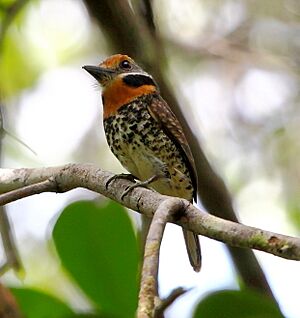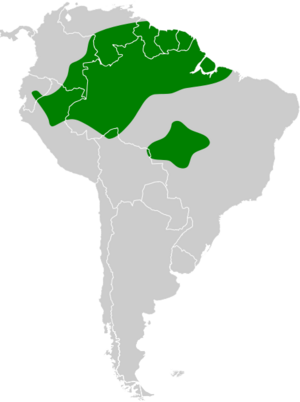Spotted puffbird facts for kids
Quick facts for kids Spotted puffbird |
|
|---|---|
 |
|
| Spotted puffbird at Presidente Figueiredo, Amazonas state, Brazil | |
| Conservation status | |
| Scientific classification | |
| Genus: |
Bucco
|
| Species: |
tamatia
|
 |
|
| Synonyms | |
|
Nystactes tamatia |
|
The spotted puffbird (Bucco tamatia) is a small, colorful bird. It belongs to a family of birds called Bucconidae, which includes puffbirds, nunlets, and nunbirds. You can find this bird in many countries in South America. These include Bolivia, Brazil, Colombia, Ecuador, French Guiana, Guyana, Peru, Suriname, and Venezuela.
Contents
About the Spotted Puffbird
How it Got its Name
People have known about the spotted puffbird for a long time. A German scientist named Georg Marcgrave first wrote about it in 1648. He used a local name for the bird, Tamatia, which came from the Tupi language. Later, in 1788, another German scientist, Johann Friedrich Gmelin, officially named it Bucco tamatia. The word Bucco is the name of its bird group.
The spotted puffbird is closely related to the sooty-capped puffbird. Sometimes, people used to put the spotted puffbird in a different group called Nystactes.
Different Kinds of Spotted Puffbirds
There are three main types, or subspecies, of the spotted puffbird:
- B. t. pulmentum: This type lives from southern Colombia down to northeastern Bolivia.
- B. t. tamatia: This is the original type. It lives in eastern Colombia, Venezuela, the Guianas, and northern Brazil.
- B. t. hypnaleus: You can find this type in central-east Brazil.
What Does a Spotted Puffbird Look Like?
The spotted puffbird is about 18 centimeters (7 inches) long. It weighs between 33 and 42 grams (about 1 to 1.5 ounces). The most common type has a light reddish-brown forehead. This color turns into reddish-brown spots on a dark brown head.
It has a black band across its eyes. Below that, there is a white stripe. Then, there is a black patch. The white stripe also goes around the back of its neck. Its back and wings are dark brown with some lighter, wavy patterns. Its tail is dark brown with light edges.
The bird's chin is white, and its throat is reddish-brown. Its chest and sides are whitish with black spots. Its belly is white with small black spots. It has a black beak and bright red eyes. Its feet are dark gray or greenish.
Listening to the Puffbird's Song
The spotted puffbird has a special song. It sings 10 to 20 soft, whistling notes. These notes sound like 'chyoi' or 'puwéep'. It sings about two notes per second. The song starts quietly and then changes pitch. It often ends with sounds like 'pchooii' or 'peejowee'.
This song is usually heard at dawn, which is early morning. Sometimes, two puffbirds will sing together. They also make quiet, wheezy whistles when they are arguing.
Where Do Spotted Puffbirds Live?
Spotted puffbirds live in many parts of South America. The main type, B. t. tamatia, lives from eastern Colombia across Venezuela and the Guianas. It also lives in Brazil, north of the Amazon River.
Another type, B. t. pulmentum, lives from southeastern Colombia down through eastern Ecuador, northeastern Peru, and western Brazil. It also reaches northeastern Bolivia. The third type, B. t. hypnaleus, lives in the Amazon region of Brazil, east of the Tapajós River.
These birds like to live in places that are somewhat open. This includes certain types of forests like várzea and igapó forests. They also live in older secondary forest (forest that has grown back after being cut). You can find them in savanna woodlands and gallery forest (forests along rivers). They usually do not live deep inside very dense forests. They are found from sea level up to about 1,400 meters (4,600 feet) high. In Venezuela, they usually stay below 700 meters (2,300 feet).
How Spotted Puffbirds Live
What Do They Eat?
The spotted puffbird usually hunts from a low branch. It quickly flies out to grab its food from leaves or tree bark. Sometimes, it follows groups of army ants to catch insects that are trying to escape.
Their diet includes many kinds of insects. They also eat other small creatures like spiders and scorpions. Sometimes, they eat small lizards and even mistletoe berries.
Reproduction and Life Cycle
The time when spotted puffbirds lay eggs changes depending on where they live. Generally, it is between March and September. They lay two eggs in a special chamber. This chamber is dug out inside a tree termite nest.
Is the Spotted Puffbird Safe?
The IUCN (International Union for Conservation of Nature) has looked at the spotted puffbird. They say it is a species of "Least Concern." This means it is not currently in danger of disappearing.
Even though it lives in a very large area, scientists don't know exactly how many spotted puffbirds there are. They believe the number might be going down. It is thought to be uncommon in most places, but it is also easy to miss. So, there might be more of them than we think. Luckily, these birds live in several protected areas.


